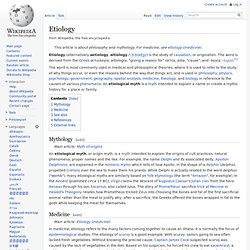

Etiology. Etiology (alternatively aetiology, aitiology /iːtiˈɒlədʒi/) is the study of causation, or origination.

The word is derived from the Greek αἰτιολογία, aitiologia, "giving a reason for" (αἰτία, aitia, "cause"; and -λογία, -logia).[1] The word is most commonly used in medical and philosophical theories, where it is used to refer to the study of why things occur, or even the reasons behind the way that things act, and is used in philosophy, physics, psychology, government, geography, spatial analysis, medicine, theology, and biology in reference to the causes of various phenomena. An etiological myth is a myth intended to explain a name or create a mythic history for a place or family. Mythology[edit] An etiological myth, or origin myth, is a myth intended to explain the origins of cult practices, natural phenomena, proper names and the like.
Medicine[edit] In medicine, etiology refers to the many factors coming together to cause an illness. See also[edit] References[edit] External links[edit] Orfizm. Orfizm veya nadir kullanımıyla Orfikizm, eski Yunanistan'da gizemli bir dindir.

Orpheus tarafından kurulduğu söylenir. Orpheus, Hadesin yer altı dünyasına gitmiş ve dönmüştür. [1] Bazı tarihçilerin bu din hakkında görüş ayrımı vardır. Hades'in dünyasına gidip de geri dönmeleri ve bu durumda öteki dünyanın avantajlarını savunmaları, erken Hristiyanlığı etkilemiş olabileceğini düşünmektedirler. İnançlar[değiştir | kaynağı değiştir] Bir din hareketi olan Orphik; şarkıcı, kahin, büyücü Orpheus'a bağlanır: Orpheus, Orphik dinin kurucusu sayılır. Yaratılış[değiştir | kaynağı değiştir] Başlangıçta Khronos (zaman) evreni yarattı. İnsandaki tanrısal ruh, bedende (soma) bir mezarda (sema) gibi hapistir, öte dünyaya kavuşmaya çabalar. Orphikçilerin öğretileri, filozof Pythagoras'ın (İ.Ö. İç Bağlantılar[değiştir | kaynağı değiştir] Derveni papyrus Notlar[değiştir | kaynağı değiştir] ^ W.
Araştırmalar[değiştir | kaynağı değiştir] Albinus, Lars. 2000. Dış bağlantılar[değiştir | kaynağı değiştir] Positivism. Positivism is the philosophy of science that information derived from logical and mathematical treatments and reports of sensory experience is the exclusive source of all authoritative knowledge,[1] and that there is valid knowledge (truth) only in this derived knowledge.[2] Verified data received from the senses are known as empirical evidence.[1] Positivism holds that society, like the physical world, operates according to general laws.

Introspective and intuitive knowledge is rejected, as is metaphysics and theology. Although the positivist approach has been a recurrent theme in the history of western thought,[3] the modern sense of the approach was developed by the philosopher Auguste Comte in the early 19th century.[4] Comte argued that, much as the physical world operates according to gravity and other absolute laws, so does society.[5] Etymology[edit] Overview[edit] Antecedents[edit] Auguste Comte[edit] Antipositivism[edit] Main article: antipositivism. Tautology (logic) Is sometimes used to denote an arbitrary tautology, with the dual symbol (falsum) representing an arbitrary contradiction.

Tautologies are a key concept in propositional logic, where a tautology is defined as a propositional formula that is true under any possible Boolean valuation of its propositional variables. A key property of tautologies in propositional logic is that an effective method exists for testing whether a given formula is always satisfied (or, equivalently, whether its negation is unsatisfiable). In 1800, Immanuel Kant wrote in his book Logic: "The identity of concepts in analytical judgments can be either explicit (explicita) or non-explicit (implicita). Here analytic proposition refers to an analytic truth, a statement in natural language that is true solely because of the terms involved.
In 1884, Gottlob Frege proposed in his Grundlagen that a truth is analytic exactly if it can be derived using logic. And representing negation, the following formula can be obtained:: . .